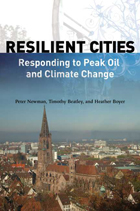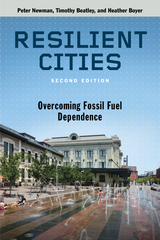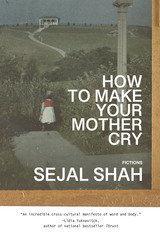3 books about Resilient Cities

Public Libraries and Resilient Cities
Michael Dudley
American Library Association, 2012

Resilient Cities
Responding to Peak Oil and Climate Change
Peter Newman, Timothy Beatley, and Heather Boyer
Island Press, 2008
Half of the world’s inhabitants now live in cities. In the next twenty years, the number of urban dwellers will swell to an estimated five billion people. With their inefficient transportation systems and poorly designed buildings, many cities—especially in the United States—consume enormous quantities of fossil fuels and emit high levels of greenhouse gases. But our planet is rapidly running out of the carbon-based fuels that have powered urban growth for centuries and we seem to be unable to curb our greenhouse gas emissions. Are the world’s cities headed for inevitable collapse?
The authors of this spirited book don’t believe that oblivion is necessarily the destiny of urban areas. Instead, they believe that intelligent planning and visionary leadership can help cities meet the impending crises, and look to existing initiatives in cities around the world. Rather than responding with fear (as a legion of doomsaying prognosticators have done), they choose hope. First, they confront the problems, describing where we stand today in our use of oil and our contribution to climate change. They then present four possible outcomes for cities: ”collapse,” “ruralized,” “divided,” and “resilient.” In response to their scenarios, they articulate how a new “sustainable urbanism” could replace today’s “carbon-consuming urbanism.” They address in detail how new transportation systems and buildings can be feasibly developed to replace our present low efficiency systems. In conclusion, they offer ten “strategic steps” that any city can take toward greater sustainability and resilience.
This is not a book filled with “blue sky” theory (although blue skies will be a welcome result of its recommendations). Rather, it is packed with practical ideas, some of which are already working in cities today. It frankly admits that our cities have problems that will worsen if they are not addressed, but it suggests that these problems are solvable. And the time to begin solving them is now.
[more]

Resilient Cities, Second Edition
Overcoming Fossil Fuel Dependence
Peter Newman, Timothy Beatley, and Heather Boyer
Island Press, 2017
What does it mean to be a resilient city in the age of a changing climate and growing inequity? As urban populations grow, how do we create efficient transportation systems, access to healthy green space, and lower-carbon buildings for all citizens?
Peter Newman, Timothy Beatley, and Heather Boyer respond to these questions in the revised and updated edition of Resilient Cities. Since the first edition was published in 2009, interest in resilience has surged, in part due to increasingly frequent and deadly natural disasters, and in part due to the contribution of our cities to climate change. The number of new initiatives and approaches from citizens and all levels of government show the promise as well as the challenges of creating cities that are truly resilient.
The authors’ hopeful approach to creating cities that are not only resilient, but striving to become regenerative, is now organized around their characteristics of a resilient city. A resilient city is one that uses renewable and distributed energy; has an efficient and regenerative metabolism; offers inclusive and healthy places; fosters biophilic and naturally adaptive systems; is invested in disaster preparedness; and is designed around efficient urban fabrics that allow for sustainable mobility.
Resilient Cities, Second Edition reveals how the resilient city characteristics have been achieved in communities around the globe. The authors offer stories, insights, and inspiration for urban planners, policymakers, and professionals interested in creating more sustainable, equitable, and, eventually, regenerative cities. Most importantly, the book is about overcoming fear and generating hope in our cities. Cities will need to claim a different future that helps us regenerate the whole planet–this is the challenge of resilient cities.
Peter Newman, Timothy Beatley, and Heather Boyer respond to these questions in the revised and updated edition of Resilient Cities. Since the first edition was published in 2009, interest in resilience has surged, in part due to increasingly frequent and deadly natural disasters, and in part due to the contribution of our cities to climate change. The number of new initiatives and approaches from citizens and all levels of government show the promise as well as the challenges of creating cities that are truly resilient.
The authors’ hopeful approach to creating cities that are not only resilient, but striving to become regenerative, is now organized around their characteristics of a resilient city. A resilient city is one that uses renewable and distributed energy; has an efficient and regenerative metabolism; offers inclusive and healthy places; fosters biophilic and naturally adaptive systems; is invested in disaster preparedness; and is designed around efficient urban fabrics that allow for sustainable mobility.
Resilient Cities, Second Edition reveals how the resilient city characteristics have been achieved in communities around the globe. The authors offer stories, insights, and inspiration for urban planners, policymakers, and professionals interested in creating more sustainable, equitable, and, eventually, regenerative cities. Most importantly, the book is about overcoming fear and generating hope in our cities. Cities will need to claim a different future that helps us regenerate the whole planet–this is the challenge of resilient cities.
[more]
READERS
Browse our collection.
PUBLISHERS
See BiblioVault's publisher services.
STUDENT SERVICES
Files for college accessibility offices.
UChicago Accessibility Resources
home | accessibility | search | about | contact us
BiblioVault ® 2001 - 2024
The University of Chicago Press









